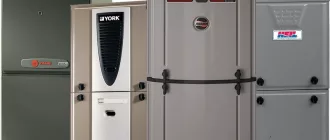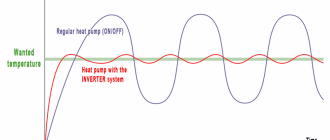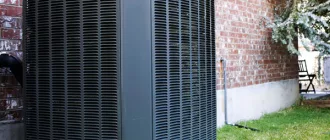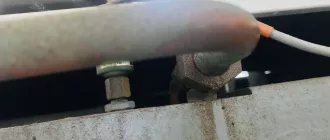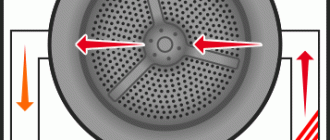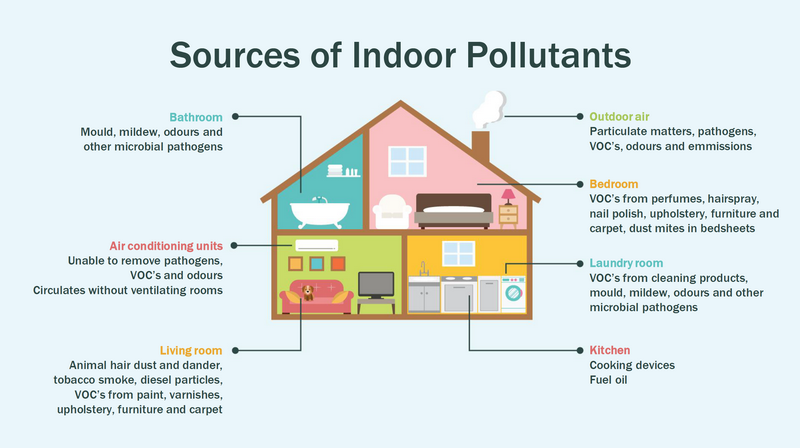
How to Improve Air Quality, Reduce Pollution in Your Central Ohio Home
Living in Central Ohio, ensuring clean and healthy air quality in your home is essential. With pollution levels on the rise, it is crucial to take proactive measures to reduce the impact on our environment and safeguard our well-being. By following a few simple steps, you can make a significant difference in the air quality of your home.
1. Keep your home clean: Regularly dusting, vacuuming, and mopping helps to reduce the amount of dust, allergens, and pollutants circulating in your home. Make sure to use eco-friendly cleaning products that do not emit harmful chemicals.
2. Proper ventilation: Ensure adequate ventilation in your home to promote fresh air circulation. Open windows to allow for natural airflow and install exhaust fans in areas prone to moisture, such as the kitchen and bathroom.
3. Indoor plants: Using indoor plants not only adds greenery to your living space but also helps to filter the air by absorbing toxins and releasing oxygen. Some plants known for their air-purifying properties include peace lilies, spider plants, and snake plants.
4. Avoid smoking indoors: Smoking indoors significantly deteriorates air quality and exposes you and your family to harmful chemicals. If you or your housemates are smokers, make it a habit to smoke outside the house.
5. Regularly check and maintain home appliances: Household appliances such as furnaces and air conditioners should be regularly inspected and maintained to ensure proper functioning. Clean or replace air filters as recommended to prevent pollutants from circulating.
6. Reduce the use of chemical-based products: Many household products, such as paints, cleaning agents, and air fresheners, release volatile organic compounds (VOCs) that contribute to air pollution. Opt for natural and organic alternatives, or minimize their use as much as possible.
By implementing these easy steps, you can significantly improve the air quality in your Central Ohio home while reducing pollution. Not only will you create a healthier living environment for yourself and your family, but you will also be doing your part in minimizing the impact on the environment. Take the first step today towards cleaner air and a greener future.
Incorporate Houseplants for Natural Air Purification
One of the easiest and most effective ways to improve the air quality in your central Ohio home is by incorporating houseplants. Not only do they add beauty and life to any space, but they also have the ability to naturally purify the air.
Houseplants are known for their ability to reduce pollutants and toxins in the air, making them an excellent addition to any home in Ohio. They can help remove common indoor air pollutants such as benzene, formaldehyde, and carbon monoxide.
Some of the best houseplants for improving indoor air quality are Spider Plants, Peace Lilies, and Boston Ferns. These plants are known for their air-purifying capabilities and can help reduce airborne allergens and improve overall air circulation in your home.
When selecting houseplants, it’s important to consider the specific needs of each plant. Some plants require more sunlight, while others thrive in low-light conditions. Additionally, certain plants may be toxic to pets, so it’s essential to choose pet-friendly options if you have furry friends in your home.
Caring for houseplants is relatively simple and can be a rewarding experience. They typically require regular watering, but it’s important not to overwater, as this can lead to root rot. Additionally, providing adequate drainage and using well-draining soil will help ensure the health and longevity of your plants.
By incorporating houseplants into your central Ohio home, you can naturally improve air quality and reduce pollution. Not only will you be benefitting from cleaner air, but you’ll also enjoy the beauty and tranquility that these plants bring to your living spaces.
Choose Non-Toxic Cleaning Products
When trying to improve air quality and reduce pollution in your central Ohio home, one simple step you can take is to choose non-toxic cleaning products. Many conventional cleaning products contain harmful chemicals that can contribute to indoor air pollution and negatively impact the health of your family and pets.
By opting for non-toxic cleaning products, you can ensure that you are not introducing harmful chemicals into your indoor environment. Look for products that are labeled as natural, organic, or eco-friendly, as these are more likely to be free from harsh chemicals.
Additionally, consider making your own cleaning solutions using simple ingredients like vinegar, baking soda, and lemon juice. These natural ingredients are effective at cleaning and disinfecting, and they don’t come with the same health risks as synthetic chemicals.
When shopping for non-toxic cleaning products, be sure to read the labels and avoid products that contain ingredients such as chlorine, ammonia, phthalates, and synthetic fragrances. These chemicals can contribute to poor indoor air quality and may even trigger allergies or respiratory issues.
In addition to choosing non-toxic cleaning products, it’s also important to properly ventilate your home while cleaning. Open windows and use fans to help circulate fresh air, especially when using cleaning solutions that may release fumes.
By choosing non-toxic cleaning products and proper ventilation, you can make a positive impact on the air quality in your central Ohio home. This not only benefits your health but also contributes to reducing pollution in your local environment.
Regularly Change Air Filters
One of the simplest ways to improve air quality and reduce pollution in your central Ohio home is to regularly change your air filters. Air filters help to trap allergens, dust, and pollutants, preventing them from circulating in the air you breathe.
Over time, these filters can become clogged and less effective at capturing particles. This can lead to poor indoor air quality and an increase in pollution. By changing your air filters on a regular basis, such as every three months or as recommended by the manufacturer, you can ensure that they remain clean and functioning properly.
When choosing air filters, look for ones with a high MERV (Minimum Efficiency Reporting Value) rating. Higher MERV ratings indicate better filtration and higher capture rates for smaller particles. Consider using filters specifically designed to remove common pollutants such as pollen, pet dander, and dust mites.
In addition to regularly changing your air filters, it’s also important to maintain your HVAC system. Schedule annual inspections and tune-ups to keep it running efficiently and to identify any issues that may be affecting air quality. Keep the area around your outdoor unit clear of debris and vegetation to prevent blockages and ensure proper airflow.
By taking these simple steps to regularly change your air filters and maintain your HVAC system, you can improve air quality, reduce pollution in your central Ohio home, and create a healthier living environment for you and your family.
Limit the Use of Volatile Organic Compounds (VOCs)
Reducing the use of volatile organic compounds (VOCs) in your central Ohio home can greatly improve air quality and reduce pollution. VOCs are chemicals that can be found in many household products, such as paints, cleaning supplies, and adhesives. These chemicals can easily evaporate into the air and contribute to indoor air pollution.
When VOCs are present in your home, they can lead to a variety of health issues, including respiratory problems, headaches, and allergic reactions. In order to improve the air quality in your home and reduce pollution, it is important to limit the use of VOCs as much as possible.
One way to limit the use of VOCs is to choose low or zero VOC products when purchasing items for your home. Look for paints, cleaning supplies, and other products that are labeled as “low VOC” or “zero VOC.” These products are specifically designed to release fewer harmful chemicals into the air.
Another way to reduce VOCs in your home is to properly ventilate when using products that contain these chemicals. Open windows and use fans to circulate fresh air when painting, cleaning, or using adhesives. This will help to minimize the concentration of VOCs in the air and prevent them from lingering in your home.
Additionally, it is important to store products that contain VOCs properly. Make sure they are tightly sealed and stored in a well-ventilated area, such as a garage or storage shed. This will help to reduce the amount of VOCs that are released into the air in your home.
By limiting the use of volatile organic compounds in your central Ohio home, you can greatly improve air quality and reduce pollution. This is not only beneficial for your health, but also for the environment. Take the necessary steps to minimize your exposure to VOCs and create a healthier living environment for you and your family.
Properly Ventilate Your Home
One of the key steps you can take to improve the air quality in your central Ohio home is to properly ventilate it. By ensuring good ventilation, you can reduce indoor air pollution and maintain a healthier living environment.
Here are a few easy steps to help you properly ventilate your home:
- Open windows and doors – Opening windows and doors allows fresh outdoor air to circulate throughout your home. This helps to flush out pollutants and keep the air fresh.
- Use exhaust fans – Installing exhaust fans in your kitchen and bathroom can help remove odors, moisture, and pollutants from indoor air. Be sure to turn them on while cooking or showering and leave them running for a while afterwards to ensure proper ventilation.
- Clean your air ducts – Regularly cleaning your air ducts can help improve the quality of the air circulating in your home. Over time, dust, allergens, and other pollutants can accumulate in the ducts, reducing indoor air quality.
- Avoid using chemicals indoors – Chemicals from cleaning products, paints, and other household items can release harmful pollutants into the air. Whenever possible, choose natural and environmentally friendly alternatives or use these products in well-ventilated areas.
- Control humidity levels – High humidity levels can promote the growth of mold and mildew, which can negatively affect air quality. Use dehumidifiers to maintain optimal humidity levels in your home.
- Consider investing in an air purifier – An air purifier can help remove airborne particles, allergens, and other pollutants from the air. Look for purifiers with HEPA filters to ensure efficient filtration.
By following these steps and properly ventilating your home, you can significantly improve the air quality and reduce pollution in your central Ohio home. Make it a priority to create a healthy living environment for you and your family.
Control Humidity Levels
One important aspect of improving air quality in your central Ohio home is to control humidity levels. Excessive humidity can lead to the growth of mold and mildew, which can contribute to poor indoor air quality and respiratory issues. On the other hand, low humidity can cause dry skin, irritated eyes, and increased susceptibility to respiratory infections.
To reduce humidity levels in your home, consider using a dehumidifier. This device helps to remove excess moisture from the air, creating a more comfortable and healthier living environment. Place the dehumidifier in areas of your home that tend to be more humid, such as the basement or bathrooms. Regularly empty and clean the dehumidifier to ensure its optimal performance.
In addition to using a dehumidifier, proper ventilation is also essential in controlling humidity levels. Ensure that your home has adequate airflow by opening windows or using fans. This can help to prevent the buildup of moisture and reduce the risk of mold and mildew growth.
Furthermore, consider using exhaust fans in high humidity areas, such as the kitchen and bathroom. These fans help to remove excess moisture caused by cooking, showering, or using the dishwasher. Make sure the exhaust fans are properly functioning and clean them regularly to promote effective air circulation and minimize humidity.
Monitoring the humidity levels in your home is also necessary. You can use a hygrometer, a device that measures humidity, to keep track of the moisture content in the air. The ideal humidity range for a comfortable and healthy living environment is between 30% and 50%. If the humidity levels consistently exceed this range, it’s crucial to take the necessary steps to control and reduce humidity to improve the air quality in your central Ohio home.
By controlling humidity levels in your home, you can significantly reduce the risk of mold and mildew growth, promote better indoor air quality, and create a healthier living environment for you and your family.
Eliminate Dust and Pet Dander
To improve air quality and reduce pollution in your central Ohio home, it’s important to eliminate dust and pet dander. These particles can contribute to respiratory problems and overall poor air quality.
Here are some easy steps you can take to eliminate dust and pet dander:
| 1. | Clean and dust regularly. |
| 2. | Vacuum carpets, rugs, and upholstery frequently. |
| 3. | Use a high-efficiency particulate air (HEPA) filter in your vacuum cleaner. |
| 4. | Wash bedding and soft furnishings in hot water regularly. |
| 5. | Keep pets out of bedrooms and off furniture. |
| 6. | Brush pets regularly to remove loose fur and dander. |
| 7. | Consider using an air purifier with a HEPA filter. |
| 8. | Keep windows and doors closed to prevent dust and pollen from entering. |
By following these simple steps, you can significantly improve the air quality in your central Ohio home and reduce the amount of dust and pet dander in the air. This will help to keep your family healthier and breathing easier.
Reduce Indoor Smoking
Smoking indoors can greatly contribute to poor air quality in your central Ohio home. Not only does it release harmful chemicals into the air, but it also leaves behind a lingering odor that can be difficult to remove.
To improve the air quality in your home and reduce the negative effects of indoor smoking, consider implementing the following steps:
- Designate a smoking area: Create a designated area outside of your home where smokers can go to smoke. By keeping smoking outside, you can prevent the harmful effects of secondhand smoke from infiltrating your home.
- Install air purifiers: Invest in an air purifier with a HEPA filter to help remove smoke particles and odors from the air. Place it in areas where smoking frequently occurs, such as a smoking room or near ashtrays.
- Improve ventilation: Ensure that your home is well-ventilated by opening windows and using fans or exhaust systems. This can help reduce the concentration of smoke particles in the air and improve overall indoor air quality.
- Keep smoking accessories clean: Regularly clean and sanitize smoking accessories, such as ashtrays and cigarette holders, to prevent the buildup of residue and odors.
- Encourage quitting or smoking outdoors: If you or someone in your home smokes, consider quitting or transitioning to smoking exclusively outdoors. This not only improves air quality but also promotes better health for everyone in the household.
By taking steps to reduce indoor smoking, you can significantly improve the air quality in your central Ohio home and create a healthier living environment for you and your family.
Manage Outdoor Air Pollution
Improving air quality and reducing pollution starts with managing outdoor air pollution in your central Ohio home. Here are some steps you can take:
|
1. Monitor Air Quality Stay informed about the air quality in your area by regularly checking air quality indexes and forecasts. This information can help you plan activities and take necessary precautions when the air quality is poor. |
|
2. Minimize Outdoor Activities On days when the air quality is particularly bad, try to minimize your outdoor activities, especially during peak pollution hours. Stay indoors as much as possible and keep windows and doors closed to prevent outdoor pollutants from entering your home. 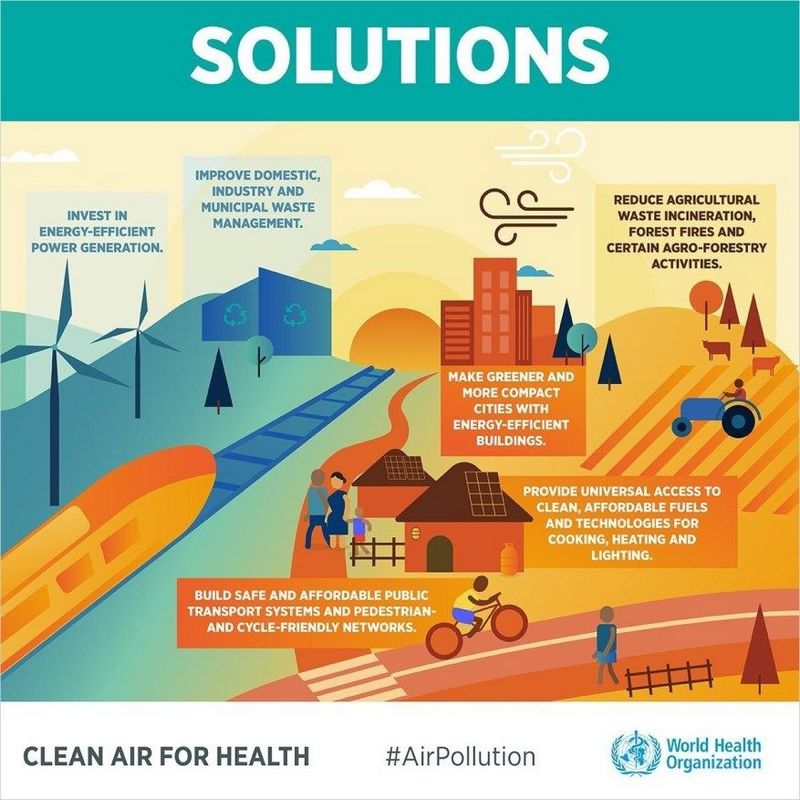 |
|
3. Use Air Purifiers Consider using air purifiers with HEPA filters in your home to remove pollutants from the air. Place them in rooms where you spend most of your time, such as bedrooms and living areas. |
|
4. Maintain Your HVAC System Regularly clean and maintain your HVAC system to ensure it is functioning properly and not circulating outdoor pollutants inside your home. Replace air filters as recommended by the manufacturer. |
|
5. Plant Trees and Shrubs Planting trees and shrubs around your home can help filter out pollutants and improve air quality. Choose native plants that are suitable for the central Ohio climate. |
|
6. Reduce Vehicle Emissions Take steps to reduce vehicle emissions, such as carpooling, using public transportation, or driving electric vehicles. These actions can help reduce air pollution in your community. |
By managing outdoor air pollution, you can create a cleaner and healthier environment inside your central Ohio home.
Avoid Using Air Fresheners
Improving air quality in your central Ohio home means taking steps to reduce pollution. One simple step you can take is to avoid using air fresheners. While they may seem appealing, air fresheners can actually contribute to poor indoor air quality.
Air fresheners often contain chemicals that can be harmful when inhaled. These chemicals can irritate the respiratory system and trigger allergies or asthma symptoms. In addition, some air fresheners release volatile organic compounds (VOCs) into the air, which can react with other pollutants and create indoor air pollution.
Instead of using air fresheners, consider using natural alternatives to keep your home smelling fresh. You can open windows to let in fresh air, use baking soda to absorb odors, or use natural essential oils for a pleasant scent. These alternatives are not only safer for your health, but they also help to reduce indoor air pollution.
- Open windows regularly to let in fresh air
- Use baking soda to absorb odors
- Use natural essential oils for a pleasant scent
By avoiding the use of air fresheners and opting for natural alternatives, you can improve the air quality in your central Ohio home and reduce pollution. Your respiratory system and overall health will thank you.
Keep Your Home Clean and Clutter-Free
In order to improve air quality and reduce pollution in your central Ohio home, it is important to keep your home clean and clutter-free. Dust and allergens can accumulate in dirty and cluttered spaces, which can negatively impact the air you breathe.
Here are some easy steps you can take to keep your home clean and clutter-free:
1. Regularly clean and dust surfaces: Dusting surfaces, including furniture, shelves, and electronics, can help remove allergens and pollutants from your home. Use a damp cloth or microfiber cloth to trap dust particles and prevent them from becoming airborne.
2. Vacuum and mop floors: Regularly vacuuming and mopping your floors can help remove dirt, dust, and other pollutants that may be trapped in carpets or on hard surfaces. Be sure to use a vacuum cleaner with a HEPA filter to effectively capture allergens.
3. Keep bedding clean: Wash your bedding, including sheets, pillowcases, and blankets, regularly to remove allergens such as dust mites. Using hypoallergenic bedding materials can also help reduce allergens in your sleeping environment.
4. Declutter and organize: Remove unnecessary items from your home to reduce clutter. Cluttered spaces are more difficult to clean and can harbor dust and allergens. Consider donating or selling items you no longer need to create a cleaner and more organized living space.
5. Use natural cleaning products: Many commercial cleaning products contain harsh chemicals that can contribute to indoor air pollution. Opt for natural cleaning products or make your own using simple ingredients like vinegar, baking soda, and lemon juice.
6. Open windows for ventilation: Proper ventilation can help improve air quality by allowing fresh air to circulate and remove stagnant indoor air. Open windows regularly, especially when cleaning or cooking, to promote air exchange.
7. Maintain a clean kitchen: Keep your kitchen clean and free of food debris to prevent the growth of mold and the attraction of pests. Regularly clean your stovetop, oven, and fridge to maintain a healthy cooking environment.
By following these easy steps to keep your central Ohio home clean and clutter-free, you can help improve air quality and reduce pollution in your living spaces. Remember to regularly maintain your cleaning routines to ensure a healthier and more comfortable home environment for you and your family.
Use Natural Fiber Furnishings and Carpets
When it comes to improving the air quality in your central Ohio home and reducing pollution, one simple step you can take is to use natural fiber furnishings and carpets. Synthetic materials often contain harmful chemicals that can release volatile organic compounds (VOCs) into the air, contributing to indoor air pollution. By opting for natural fiber furnishings and carpets, you can create a healthier and cleaner living space.
Natural fiber furnishings, such as sofas, chairs, and bedding, are made from materials like cotton, linen, silk, and wool. These materials are biodegradable and do not emit pollutants into the air. They are also more breathable, which can help prevent the buildup of dust, allergens, and other airborne particles. By choosing natural fiber furnishings, you can improve air quality and create a more comfortable and safe home environment.
In addition to natural fiber furnishings, using carpets made from natural fibers can also contribute to better air quality in your home. Synthetic carpets, often made from petroleum-based materials, can emit harmful chemicals known as VOCs. These chemicals can linger in the air, leading to respiratory problems and other health issues. Natural fiber carpets, on the other hand, are made from materials like wool, jute, sisal, and seagrass. These fibers are non-toxic, renewable, and environmentally friendly. They do not release harmful pollutants into the air, making them a better choice for your home.
When selecting natural fiber furnishings and carpets, be sure to look for products that are certified as organic and free from harmful chemicals. This ensures that you are truly reducing pollution and improving air quality in your central Ohio home. By making this change, you can create a healthier living environment for yourself and your family.
| 1. Improved air quality |
| 2. Reduced pollution |
| 3. Non-toxic and environmentally friendly |
| 4. Breathable materials that prevent dust and allergen buildup |
| 5. Creates a healthier and cleaner home environment |
Regularly Maintain Your HVAC System
To improve the air quality and reduce pollution in your central Ohio home, it is crucial to regularly maintain your HVAC system. The HVAC system is responsible for heating, ventilation, and air conditioning, and ensuring its proper functioning is essential for a healthy and clean indoor environment.
Regular maintenance of your HVAC system includes cleaning or replacing air filters, inspecting and cleaning ducts, and checking for any leaks or blockages. Dirty or clogged air filters can lead to poor air quality and reduced airflow, while leaky ducts can result in the circulation of dust, allergens, and other pollutants throughout your home.
By keeping your HVAC system in good condition, you can improve the air quality in your home and reduce the amount of pollution produced. Additionally, regular maintenance can prolong the lifespan of your system, save energy, and lower your utility bills.
It is recommended to schedule an annual maintenance appointment with a professional HVAC technician who can thoroughly inspect and service your system. They will be able to identify any issues and provide necessary repairs or adjustments. In between professional maintenance visits, be sure to regularly check and change your air filters according to the manufacturer’s guidelines.
Improving air quality and reducing pollution in your central Ohio home starts with maintaining your HVAC system. By taking these easy steps, you can enjoy cleaner, healthier air for you and your family.
Monitor and Control Indoor Radon Levels
Reducing air pollution and improving indoor air quality in your central Ohio home involves monitoring and controlling indoor radon levels. Radon is a colorless and odorless gas that can seep into homes through cracks and gaps in the foundation, posing a risk to your health.
Here are some easy steps to monitor and control indoor radon levels:
- Conduct a Radon Test: Start by conducting a radon test in your home to determine the level of radon present. Radon testing kits are readily available and can be easily used to collect air samples.
- Seek Professional Help: If the radon levels in your home are high, it’s important to seek professional help. Certified radon mitigation contractors can install appropriate systems to reduce radon entry into your home.
- Seal Cracks and Gaps: Seal any cracks or gaps in your home’s foundation, walls, and floors to prevent radon from entering. This can be done using caulk, sealants, and other appropriate materials.
- Improve Ventilation: Increase ventilation in your home by opening windows and using exhaust fans. Improved airflow can help dilute and remove radon gas from your living spaces.
- Regular Radon Testing: Regularly test radon levels in your home to ensure they remain within safe limits. Radon levels can fluctuate over time, so periodic testing is essential.
By monitoring and controlling indoor radon levels, you can significantly reduce the risk of radon-related health issues and improve the overall air quality in your central Ohio home.
Avoid Burning Wood and Other Fuels Indoors
One simple step you can take to improve the air quality in your central Ohio home is to avoid burning wood and other fuels indoors. While it might be tempting to cozy up to a roaring fire on a cold winter night, burning wood or other fuels can release harmful pollutants into the air.
Burning wood releases fine particulate matter, carbon monoxide, nitrogen oxides, and other chemicals that can contribute to poor air quality. These pollutants can irritate the respiratory system and exacerbate existing health conditions such as asthma and allergies.
If you rely on a wood-burning fireplace or stove for heating, consider switching to cleaner alternatives such as natural gas or electric heating. These options produce fewer emissions and can help reduce air pollution in your home.
Additionally, avoid burning other fuels such as coal, oil, or charcoal indoors. These fuels can also release pollutants into the air and contribute to indoor air pollution.
Instead of burning wood or other fuels indoors, opt for alternative heating and cooking methods. Use electric or gas-powered stoves for cooking, and invest in a high-efficiency furnace or heat pump for heating your home. These measures can help improve air quality and reduce pollution in your central Ohio home.
By avoiding the burning of wood and other fuels indoors, you can contribute to the overall improvement of air quality and create a healthier living environment for you and your family.
Q&A:
What are some easy steps to improve air quality in my home?
There are several easy steps you can take to improve air quality in your home. First, make sure your home is properly ventilated by opening windows and using exhaust fans. Second, regularly clean and vacuum your home to remove dust and allergens. Third, consider using air purifiers or plants that purify the air. Lastly, avoid using harsh chemicals and opt for natural cleaning products.
How can I reduce pollution in my home?
Reducing pollution in your home is important for maintaining good air quality. You can start by reducing your energy consumption by using energy-efficient appliances and turning off lights when not in use. Additionally, avoid smoking indoors and properly dispose of household chemicals. It’s also beneficial to properly maintain your heating and cooling systems and regularly change air filters.
Are there any specific plants that can help improve air quality in my home?
Yes, there are several plants that are known for purifying the air. Some of these plants include snake plants, pothos, peace lilies, and spider plants. These plants can help remove toxins and improve overall air quality in your home.
Is it important to regularly clean and vacuum my home?
Yes, regularly cleaning and vacuuming your home is important for improving air quality. Dust and allergens can accumulate in carpets, furniture, and other surfaces, and cleaning and vacuuming helps to remove these particles. It’s especially important to vacuum carpets and rugs, as they can trap dust mites and other allergens.
What are some natural cleaning products I can use in my home?
There are several natural cleaning products that you can use in your home. Some examples include vinegar, baking soda, lemon juice, and hydrogen peroxide. These products are effective for cleaning and disinfecting surfaces, and they are also safer for the environment and your health compared to harsh chemical cleaners.
How can I improve air quality in my home?
There are several steps you can take to improve air quality in your home. First, make sure your home is well-ventilated by opening windows or using exhaust fans. Additionally, you can invest in air purifiers or houseplants that can help filter out pollutants. Regularly cleaning and dusting your home can also reduce the presence of allergens and other pollutants. Lastly, avoid using harsh cleaning products or smoking indoors, as these can significantly degrade indoor air quality.
What are some easy ways to reduce pollution in my home?
There are a few simple steps you can take to reduce pollution in your home. Firstly, try to limit the use of products that release harmful chemicals, such as aerosol sprays or certain cleaning products. Instead, opt for natural alternatives. Secondly, consider using energy-efficient appliances and light bulbs to minimize the amount of pollution generated. Lastly, ensure proper ventilation in your home to prevent the buildup of pollutants. Opening windows or using fans can help circulate fresh air and reduce pollution.


